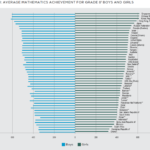Have we reached gender equity in mathematics education?
Evidence from TIMSS South Africa 2011

Results from TIMSS 2011 point to the presence of new complexities in the schooling experience of South African boys and girls.
On average, across South Africa, gender differences in mathematics test results were small or non-existent. Achievement levels for both boys and girls remained low based on international standards.
When fee-paying, no fee and independent schools were compared, boys and girls within each school grouping achieved similar results.
By contrast, girls from independent and fee paying schools were more academically advantaged than girls from no fee schools. The same pattern applied to boys.
The achievement gap favoured boys in no-fee schools when older learners were compared.
The relationship between attitudes and achievement differed for boys and girls. It was also dependent on the type of school that learners attended.
Gender differences in educational expectations favoured girls in South African schools.
Girls also reported a higher level of parental engagement than boys.
Boys were overrepresented among learners who were victims of bullying. Boys in independent schools experienced bullying with equal frequency as boys in less affluent schooling environments
